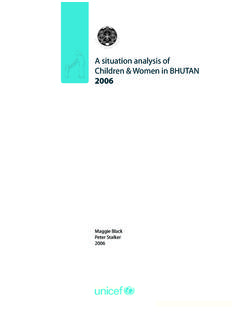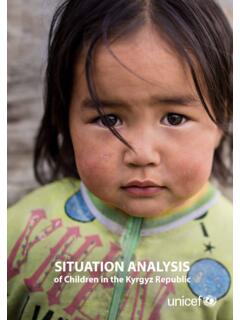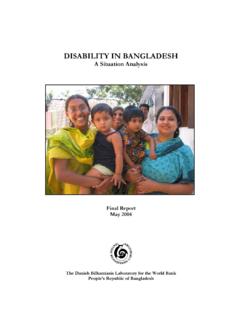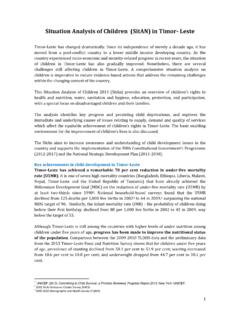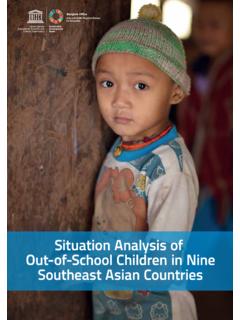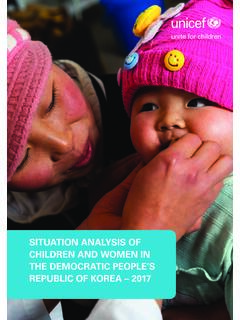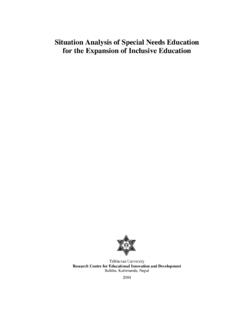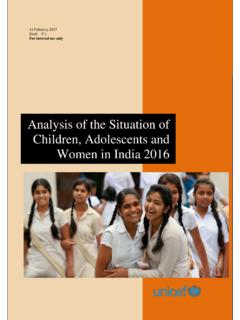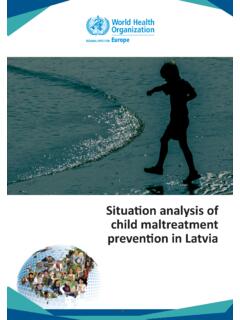Transcription of Situation analysis of newborn health in Tanzania
1 Current Situation , existing plans and strategic next steps for newborn health Situation analysis of newborn health in TanzaniaUnited Republicof TanzaniaThe content of this publication and opinions expressed herein are those of the authors and do not necessarily refl ect the views of partner agencies or organisations. This publication may be used or reproduced for educa-tional or non-commercial purposes, provided that the material is accompanied by an acknowledgment. Suggested citation: Manji, K. Situation analysis of newborn health in Tanzania : Current Situation , existing plans and strategic next steps for newborn health .
2 Dar es Salaam: Ministry of health and Social Welfare, Save the children ; OF CONTENTSF oreword 4 Acknowledgments 5 Acronyms 6 Introduction 7 Chapter 1: The state of Tanzania s newborns 11 Neonatal survival: current levels and trends 11 Causes of newborn death and illness in Tanzania 12 Maternal health and newborn survival 17 Poverty, inequity and social determinants of illness and mortality 17 Chapter 2: Coverage and quality of services for newborn health 19 Saving newborn lives through a continuum of care 19 Antenatal care 19 Childbirth and intrapartum care 24 Postnatal care 28 Chapter 3: Newborns in the context of the Tanzanian health care system 33 Structure of the Tanzanian health system relating to newborn health 33 newborn health within existing national plans 37 Financing for newborn health 39 Role of development partners and civil society 40 Chapter 4.
3 Strengths, challenges and opportunities for newborn health 43 Strengths of existing structures for newborn care in Tanzania 43 Gaps and missed opportunities for newborn health 43 Priority recommendations for improving newborn health 46 Chapter 5: Data for action 49 Tanzania 50 Central Zone Dodoma, Singida 51 Eastern Zone Dar es Salaam, Morogoro, Pwani 52 Lake Zone Kagera, Mara, Mwanza 53 Northern Zone Arusha, Kilimanjaro, Manyara, Tanga 54 Southern Zone Lindi, Mtwara, Ruvuma 55 Southern Highlands Zone Iringa, Mbeya, Rukwa 56 Western Zone Kigoma, Shinyanga, Tabora 57 Zanzibar Pemba North, Pemba South, Town West, Zanzibar North, Zanzibar South 58 References 59 Appendix 1: Six district survey report 62 Appendix 2.
4 Household interview questionnaire 66 Appendix 3: Survey at three district hospitals in Dar es Salaam 69 Appendix 4: health facility data collection tool 7344 FOREWORDR eduction of maternal and newborn deaths is a high priority for all given the persistently high maternal and newborn morbidity and mortality rates over the past two decades in African countries; Tanzania included. It is one of the major concerns addressed by various global and national commitments, and refl ected in the targets of the Millennium Development Goals, Tanzania Vision 2025, the National Strategy for Growth and Reduction of Poverty (NSGRP-MKUKUTA), and the Primary health Services Development Program (PHSDP-MMAM), among deaths are caused by factors attributable to pregnancy, childbirth and poor quality of health services.
5 newborn deaths are related to the same issues and occur mostly during the fi rst week of life. Improving access to quality health services for the mother and newborn requires evidence-based and goal-oriented health and social policies and interventions that are informed by best Situation analysis of newborn health was developed as Tanzania renewed its national response to improving newborn care. The Reproductive and Child health Section (RCHS) of the Ministry of health and Social Welfare in collaboration with developmental partners, particularly Saving newborn Lives/Save the children carried out this analysis to guide implementation of newborn health interventions inTanzania.
6 This Situation analysis will provide information and guidance on the way is the expectation of the Government, particularly the Ministry of health and Social Welfare, that all stakeholders will make optimal use of this analysis to support the implementation of newborn health interventions, in line with the national health policy and existing Integrated Management of Childhood Illness (IMCI) standards, guidelines and Government highly values the commitment of all stakeholders in working toward the goals of the National Road Map Strategic Plan to Accelerate Reduction of Maternal, newborn and Child Deaths in Tanzania .
7 Together, we can improve the health of Tanzanian mothers, babies and children , and build a stronger and more prosperous S. J. NyoniPERMANENT SECRETARYMINISTRY OF health AND SOCIAL WELFARE5 ACKNOWLEDGMENTSThe Ministry of health and Social Welfare (MoHSW) wish to express its gratitude to individuals and organisations that facilitated the development of the Situation analysis of newborn health in Tanzania . Special appreciation goes to the author, Professor Karim Manji of the Muhimbili University of health and Allied Sciences (MUHAS).
8 Sincere acknowledgment goes to Ndeserua Rabi, Festo Germinian, Msami Evarist, Kepha Bernard, Juma Athuman, Moris Mwanyika, semester 9-10 medical students at MUHAS, for their efforts in data collection from six regions in Tanzania . Many thanks to the core team of Dr Catherine Sanga, Dr Neema Rusibamayila and Dr Georgina Msemo (MoHSW); Dr Theopista John (WHO); Dr Asia Hussein (UNICEF); Ms Anne Ndirangu (Save the children -UK); Dr Roderick Kisenge (Paediatric Association of Tanzania ); Professor Richard Lema (Association of Gynaecologists and Obstetricians in Tanzania ); and Dr Joanna Schellenberg (Ifakara health Institute).
9 The MoHSW gratefully acknowledges the contribution of Judith Fullerton (Project Concern International) and Rene Salgado (John Snow, Inc) for their valuable work on a background thanks to Kate Kerber and Joy Lawn (Save the children -US), for valuable technical inputs, to Elizabeth Arend for editing the fi nal draft and The Miracle Book for design and layout. Appreciations go to Saving newborn Lives/Save the children -US for providing fi nancial support for the development of this document. Dr Deo M. MtasiwaCHIEF MEDICAL OFFICERMINISTRY OF health AND SOCIAL WELFARE66 What is known about newborn mortality?
10 Globally Deaths during the fi rst month of life the newborn period account for 40 percent of the nearly 10 million child deaths under the age of fi ve years. This amounts to nearly 4 million deaths annually. Ninety-nine percent of newborn deaths occur in developing countries. Three-quarters of deaths occur in the fi rst seven days of life; about half of these deaths occur on the fi rst day of life. Many more babies die as stillbirths and countless others are born with life-threatening Tanzania Tanzania has substantially reduced child mortality in the past fi ve years, but most of the decline has come after the fi rst month of life and neonatal mortality has not reduced.
